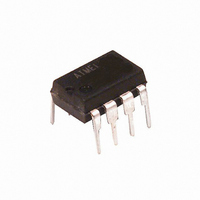AT17C512-10PC Atmel, AT17C512-10PC Datasheet - Page 3

AT17C512-10PC
Manufacturer Part Number
AT17C512-10PC
Description
IC SRL CONFIG EEPROM 512K 20PLCC
Manufacturer
Atmel
Datasheet
1.AT17C512-10JC.pdf
(13 pages)
Specifications of AT17C512-10PC
Programmable Type
Serial EEPROM
Memory Size
512kb
Voltage - Supply
4.75 V ~ 5.25 V
Operating Temperature
0°C ~ 70°C
Package / Case
20-LCC (J-Lead)
Lead Free Status / RoHS Status
Contains lead / RoHS non-compliant
Available stocks
Company
Part Number
Manufacturer
Quantity
Price
Company:
Part Number:
AT17C512-10PC
Manufacturer:
Freescale
Quantity:
1 122
Condition 1
Condition 2
Cascading Serial
Configuration
EEPROMs
AT17 Series Reset
Polarity
RESET
The simplest connection is to have the FPGA CON pin drive both CE and RESET/OE
in parallel. Due to its simplicity, however, this method will fail if the FPGA receives an
external reset condition during the configuration cycle. If a system reset is applied to the
FPGA, it will abort the original configuration and then reset itself for a new configuration,
as intended. Of course, the AT17 Series Configurator does not see the external reset
signal and will not reset its internal address counters and, consequently, will remain out
of sync with the FPGA for the remainder of the configuration cycle.
Note:
Figure 1. Condition 2 Connection
Notes:
The FPGA CON output drives only the CE input of the AT17 Series Configurator, while
the RESET/OE input is driven by the FPGA INIT pin (Figure 1). This connection works
under all normal circumstances, even when the user aborts a configuration before CON
has gone high. A Low level on the RESET/OE
Configurator’s internal address pointer, so that the reconfiguration starts at the
beginning.
Note:
The AT17 Series Configurator does not require an inverter for either condition since the
RESET polarity is programmable.
For multiple FPGAs configured as a daisy-chain, or for future FPGAs requiring larger
configuration memories, cascaded Configurators provide additional memory.
As the last bit from the first Configurator is read, the clock signal to the Configurator
asserts its CEO output Low and disables its DATA line driver. The second Configurator
recognizes the Low level on its CE input and enables its DATA output.
After configuration is complete, the address counters of all cascaded Configurators are
reset if the RESET/OE on each Configurator is driven to its active (default High) level.
If the address counters are not to be reset upon completion, then the RESET/OE input
can be tied to its inactive (default Low) level.
The AT17 Series Configurator allows the user to program the reset polarity as either
RESET/OE or RESET/OE. This feature is supported by industry-standard programmer
algorithms. For more details on programming the EEPROMs reset polarity, please
1. For this condition, the reset polarity of the EEPROM must be set active High.
1. Use of the READY pin is optional. The READY pin is not available in the 8-pin
2. Reset polarity of EEPROM must be set active Low.
1. For this condition the reset polarity of the EEPROM must be set active Low.
DPDIP/SOIC package.
GND
RESET
M2
M1
M0
AT40K
CCLK
D<0>
CON
INIT
AT17C512/010/LV512/010
(1)
input – during FPGA reset – clears the
DATA
CLK
CE
RESET/OE
AT17LV512/010
AT17C512/010
SER_EN
READY
VCC
(1)
3
















